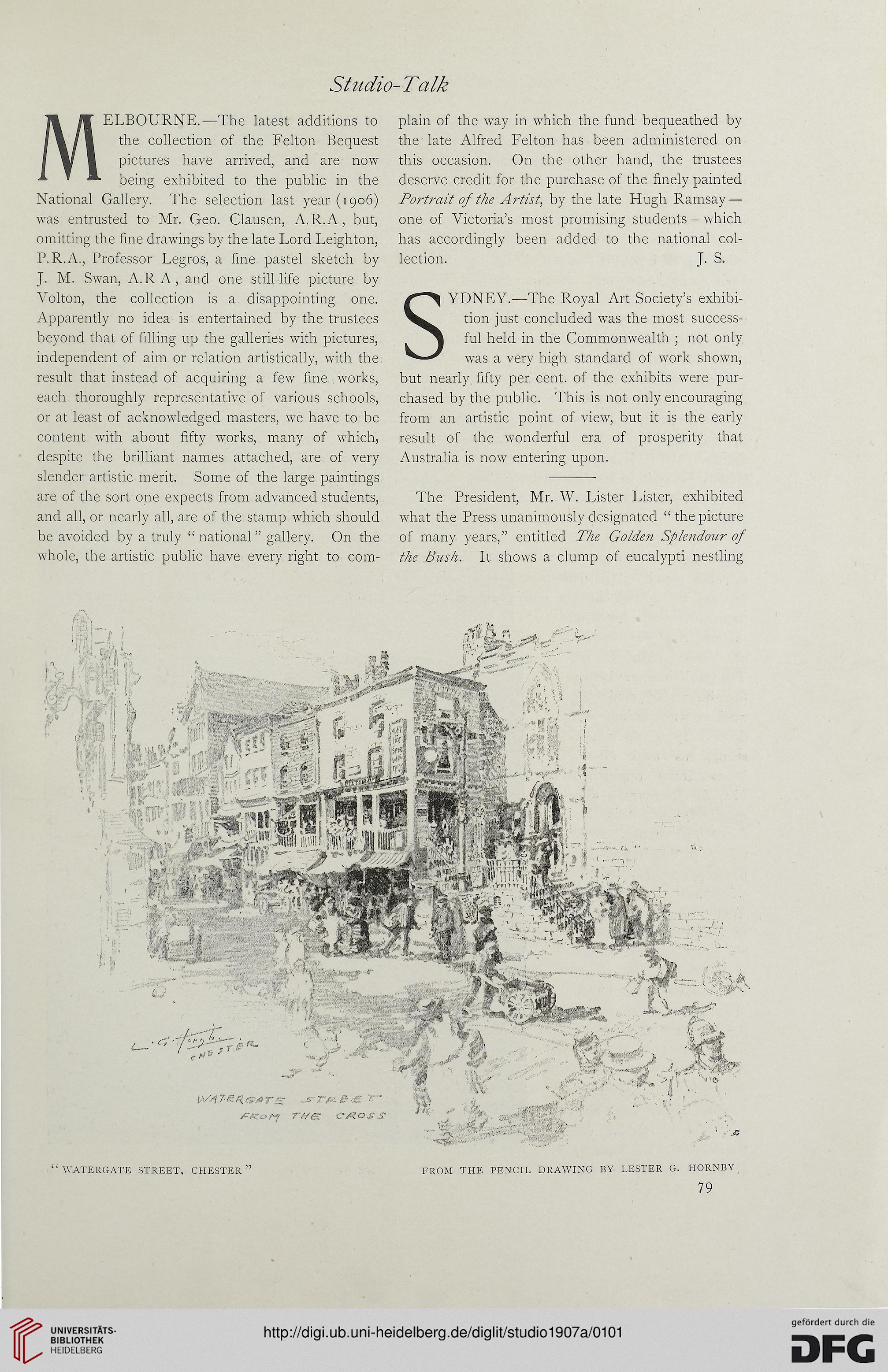Studio-Talk
MELBOURNE.—The latest additions to
the collection of the Felton Bequest
pictures have arrived, and are now
being exhibited to the public in the
National Gallery. The selection last year (1906)
was entrusted to Mr. Geo. Clausen, A.R.A, but,
omitting the fine drawings by the late Lord Leighton,
P.R.A., Professor Legros, a fine pastel sketch by
J. M. Swan, A.RA, and one still-life picture by
Volton, the collection is a disappointing one.
Apparently no idea is entertained by the trustees
beyond that of filling up the galleries with pictures,
independent of aim or relation artistically, with the.
result that instead of acquiring a few fine works,
each thoroughly representative of various schools,
or at least of acknowledged masters, we have to be
content with about fifty works, many of which,
despite the brilliant names attached, are of very
slender artistic merit. Some of the large paintings
are of the sort one expects from advanced students,
and all, or nearly all, are of the stamp which should
be avoided by a truly “ national ” gallery. On the
whole, the artistic public have every right to com-
plain of the way in which the fund bequeathed by
the late Alfred Felton has been administered on
this occasion. On the other hand, the trustees
deserve credit for the purchase of the finely painted
Portrait of the Artist, by the late Hugh Ramsay —
one of Victoria’s most promising students—which
has accordingly been added to the national col-
lection. J. S.
SYDNEY.—The Royal Art Society’s exhibi-
tion just concluded was the most success-
ful held in the Commonwealth ; not only
was a very high standard of work shown,
but nearly fifty per cent, of the exhibits were pur-
chased by the public. This is not only encouraging
from an artistic point of view, but it is the early
result of the wonderful era of prosperity that
Australia is now entering upon.
The President, Mr. W. Lister Lister, exhibited
what the Press unanimously designated “the picture
of many years,” entitled The Golde?i Splendour of
the Bush. It shows a clump of eucalypti nestling
MELBOURNE.—The latest additions to
the collection of the Felton Bequest
pictures have arrived, and are now
being exhibited to the public in the
National Gallery. The selection last year (1906)
was entrusted to Mr. Geo. Clausen, A.R.A, but,
omitting the fine drawings by the late Lord Leighton,
P.R.A., Professor Legros, a fine pastel sketch by
J. M. Swan, A.RA, and one still-life picture by
Volton, the collection is a disappointing one.
Apparently no idea is entertained by the trustees
beyond that of filling up the galleries with pictures,
independent of aim or relation artistically, with the.
result that instead of acquiring a few fine works,
each thoroughly representative of various schools,
or at least of acknowledged masters, we have to be
content with about fifty works, many of which,
despite the brilliant names attached, are of very
slender artistic merit. Some of the large paintings
are of the sort one expects from advanced students,
and all, or nearly all, are of the stamp which should
be avoided by a truly “ national ” gallery. On the
whole, the artistic public have every right to com-
plain of the way in which the fund bequeathed by
the late Alfred Felton has been administered on
this occasion. On the other hand, the trustees
deserve credit for the purchase of the finely painted
Portrait of the Artist, by the late Hugh Ramsay —
one of Victoria’s most promising students—which
has accordingly been added to the national col-
lection. J. S.
SYDNEY.—The Royal Art Society’s exhibi-
tion just concluded was the most success-
ful held in the Commonwealth ; not only
was a very high standard of work shown,
but nearly fifty per cent, of the exhibits were pur-
chased by the public. This is not only encouraging
from an artistic point of view, but it is the early
result of the wonderful era of prosperity that
Australia is now entering upon.
The President, Mr. W. Lister Lister, exhibited
what the Press unanimously designated “the picture
of many years,” entitled The Golde?i Splendour of
the Bush. It shows a clump of eucalypti nestling




